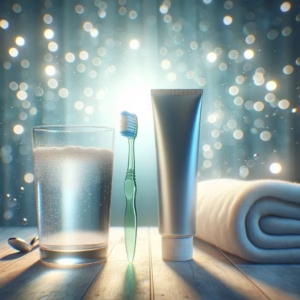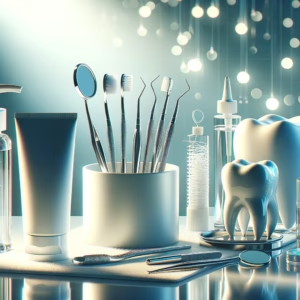Understanding the Basics of Oral Hygiene
Understanding the Basics of Oral Hygiene
Maintaining good oral hygiene is essential for achieving optimal dental health and preventing a host of oral diseases. For adults, adopting a comprehensive oral hygiene routine that incorporates brushing, flossing, and mouthwash usage is crucial. Each of these practices plays a unique role in promoting oral health.
Brushing
Brushing your teeth is the cornerstone of effective oral hygiene. It is recommended that adults brush their teeth at least twice a day—once in the morning and once before bed. The American Dental Association (ADA) suggests using a fluoride toothpaste, as fluoride helps strengthen tooth enamel and reduces the risk of cavities.
When brushing, it’s important to use a soft-bristled toothbrush to minimize gum irritation. Aim to brush for at least two minutes, ensuring you cover all surfaces of your teeth: outer, inner, and chewing surfaces. A gentle, circular motion is recommended to dislodge plaque and food particles effectively. Don’t forget to brush your tongue, too; bacteria can accumulate there and contribute to bad breath.
Flossing
Flossing is another critical component of oral hygiene that many adults overlook. Flossing helps remove food particles and plaque from between the teeth, areas that a toothbrush cannot reach. The ADA recommends flossing at least once a day, ideally before bedtime.
To floss correctly, use about 18 inches of dental floss, winding it around your fingers and holding it taut. Gently slide the floss between your teeth, making a C-shape around each tooth to clean the sides effectively. Be careful not to snap the floss, as this can harm your gums. Regular flossing can significantly reduce the risk of gum disease and cavities.
Mouthwash
Incorporating mouthwash into your oral hygiene routine can provide an additional layer of protection. Mouthwash can help reduce plaque, prevent gingivitis, and freshen breath. There are two main types of mouthwash: cosmetic and therapeutic. Cosmetic mouthwashes temporarily mask bad breath, while therapeutic mouthwashes contain active ingredients that can help reduce oral health problems.
When selecting a mouthwash, look for one that is ADA-approved and contains fluoride. Follow the instructions on the label, typically rinsing for 30 seconds to one minute after brushing and flossing. Mouthwash should not replace brushing and flossing but serves as a valuable supplement to your routine.
By understanding and implementing these basic practices of oral hygiene—brushing, flossing, and using mouthwash—adults can significantly enhance their dental health and maintain a bright, confident smile. Regular visits to the dentist for professional cleanings and check-ups are also essential for monitoring oral health and addressing any issues that may arise.
Importance of Regular Dental Check-ups
Importance of Regular Dental Check-ups
In addition to maintaining good daily oral hygiene practices, regular dental check-ups are an indispensable aspect of long-term oral health. These visits, typically recommended every six months, serve multiple purposes that contribute to the overall health of your teeth and gums.
Early Detection of Oral Health Issues
One of the primary benefits of regular dental check-ups is the early detection of dental issues that may not yet be obvious to the patient. Conditions such as cavities, gum disease, and even oral cancers can develop without noticeable symptoms. During these check-ups, dentists perform thorough examinations and may use digital imaging to identify problems before they escalate. Catching these issues early can often lead to simpler, less invasive treatments and better health outcomes.
Professional Cleanings
Dental cleanings performed by hygienists during check-ups are vital for removing plaque and tartar that regular brushing and flossing cannot eliminate. Even the most diligent brushers can fall short, as plaque can harden into tartar, which can only be removed with professional tools. These cleanings play a crucial role in preventing gum disease and maintaining a healthy mouth.
Personalized Oral Health Guidance
During check-ups, dentists also provide personalized recommendations based on individual oral health needs. They can assess your brushing and flossing techniques, suggest specific products, and offer tailored advice for improving your oral hygiene routine. This guidance can empower patients to take better care of their teeth, ultimately contributing to enhanced oral health.
Assessment of Overall Health
Moreover, regular dental visits allow dentists to assess not just oral health but also how it relates to overall health. Research has shown links between oral health and conditions like diabetes, heart disease, and respiratory issues. Dentists can serve as an important resource for identifying potential health problems that may manifest through oral symptoms, facilitating a more holistic approach to health care.
Building a Relationship with Your Dentist
Establishing a consistent pattern of visits helps build a relationship with your dentist, fostering an environment of trust and open communication. Patients who regularly see their dentist are more likely to keep up with recommended treatments and engage in proactive measures to protect their oral health.
In summary, regular dental check-ups and cleanings are critical components of maintaining long-term oral health. They not only help catch issues early but also provide patients with the knowledge and resources necessary to sustain their oral hygiene effectively.
Tools for Effective Teeth Cleaning
Tools for Effective Teeth Cleaning
Choosing the right tools for teeth cleaning is essential for maintaining optimal oral hygiene. A variety of products are available, each designed to cater to specific needs and preferences. Here’s an overview of the key tools and products you should consider for your oral hygiene routine.
Toothbrushes
Toothbrushes come in various types, including manual and electric options. When selecting a toothbrush, consider the following:
Bristle Type: Soft-bristled toothbrushes are generally recommended by dental professionals because they are gentle on the gums while effectively cleaning teeth. Medium or hard bristles can cause gum recession and enamel wear.
Size and Shape: Choose a toothbrush head that fits comfortably in your mouth and can reach all areas of your teeth. Smaller heads can be beneficial for those with tight spaces between teeth or for children.
Electric vs. Manual: Electric toothbrushes can provide a more thorough cleaning due to their oscillating or vibrating action, making them easier for some individuals to use effectively. However, manual toothbrushes can be just as effective when used correctly.
Toothpaste
Toothpaste is another critical component of your oral care regimen. When selecting toothpaste, look for:
Fluoride Content: Fluoride helps to strengthen tooth enamel and prevent cavities. Most ADA-approved toothpastes contain fluoride.
Specific Needs: If you have specific dental concerns, such as sensitivity, whitening, or tartar control, look for toothpaste formulated to address those issues. For example, sensitivity toothpaste contains compounds that help reduce sensitivity to hot or cold stimuli.
ADA Seal of Approval: Check for the ADA Seal of Acceptance on the packaging, which ensures the toothpaste meets safety and effectiveness standards.
Dental Floss
Choosing the right dental floss is crucial for effective interdental cleaning. Consider these options:
Type of Floss: Dental floss comes in waxed and unwaxed varieties. Waxed floss is easier to slide between tight contacts, while unwaxed floss may be more effective at removing plaque.
Floss Thickness: Some brands offer thicker floss designed for wider gaps between teeth and thinner floss for tighter spaces. Choose a type that suits your dental anatomy.
Alternatives: If traditional flossing is challenging, consider alternatives such as floss picks or pre-threaded flossers for convenience.
Water Flossers
Water flossers, also known as oral irrigators, use a stream of pulsating water to remove plaque and food debris between teeth and along the gum line. When considering a water flosser:
Features: Look for models with adjustable pressure settings to customize the water flow to your comfort level. Some also offer various tips for specific needs, such as braces or periodontal care.
Ease of Use: Choose a model that is easy to fill, clean, and store. Cordless options can offer convenience for travel or small bathrooms.
Selecting the Right Tools
When choosing dental care products, consider your individual needs, preferences, and any specific dental concerns you may have. Consult with your dentist for personalized recommendations tailored to your oral health. Remember that the most effective routine combines the right tools with proper techniques and regular dental check-ups.
Techniques for Proper Brushing
Techniques for Proper Brushing
To maximize the effectiveness of your brushing routine, it’s important to follow specific techniques. Here’s a step-by-step guide that covers the duration, pressure, and motion of brushing:
Choose the Right Toothbrush: Select a soft-bristled toothbrush that fits comfortably in your mouth. An electric toothbrush can also be a good option, as it encourages a more consistent brushing technique.
Use Fluoride Toothpaste: Apply a pea-sized amount of fluoride toothpaste to your toothbrush. Fluoride strengthens enamel and helps prevent cavities.
Position Your Toothbrush: Hold your toothbrush at a 45-degree angle to your gums. This angle allows the bristles to reach the plaque and debris at the gum line effectively.
Start Brushing: Begin with the outer surfaces of your teeth. Use gentle, circular motions to brush the fronts of your teeth, ensuring you cover each tooth thoroughly. Aim for about 15-20 seconds per quadrant (upper left, upper right, lower left, lower right).
Focus on Inner Surfaces: Move to the inner surfaces of your teeth, still using a gentle, circular motion. It’s important to keep the same 45-degree angle to ensure you’re cleaning along the gum line.
Brush Chewing Surfaces: For the chewing surfaces of your molars, use a flat scrubbing motion. Be sure to spend time on these areas, as they can trap food particles.
Brush Your Tongue: Gently brush your tongue with the toothbrush to remove bacteria and freshen your breath. This can be done after you finish brushing your teeth.
Duration: Brush for at least two minutes. You can time yourself or use a toothbrush with a built-in timer to ensure you meet the recommended duration.
Pressure: Use light pressure when brushing. Pressing too hard can damage your gums and enamel. A good rule of thumb is to let the weight of the toothbrush do the work.
Rinse and Spit: Once you’ve finished brushing, rinse your mouth thoroughly with water and spit out the excess toothpaste.
Routine Maintenance: Replace your toothbrush every three to four months or sooner if the bristles become frayed. An effective toothbrush is crucial for maintaining your oral health.
By following these techniques for proper brushing, you can ensure that you are effectively cleaning your teeth and promoting good oral hygiene practices.
Tips for Flossing Like a Pro
Tips for Flossing Like a Pro
Flossing is an indispensable part of any oral hygiene routine, yet many people still don’t do it correctly or consistently. Mastering the art of flossing can lead to improved gum health and a brighter smile. Here are some best practices to ensure you’re flossing effectively:
Frequency
The American Dental Association recommends flossing at least once a day. The ideal time to floss is before bedtime, as this allows you to remove food particles and plaque that have accumulated throughout the day. However, if you prefer, you can also floss in the morning. The key is to make it a regular part of your routine to achieve the best results.
Technique
To floss properly, cut about 18 inches of dental floss. Wind most of it around the middle finger of one hand and the rest around the middle finger of the opposite hand, leaving about 1-2 inches to work with. Hold the floss taut between your thumbs and index fingers. Gently insert the floss between your teeth, using a back-and-forth motion to avoid snapping it against your gums. When the floss reaches the gum line, curve it into a C-shape around the base of each tooth, sliding it gently underneath the gum line without forcing it. Repeat this process for each tooth, using a fresh section of floss as needed.
Flossing with Braces or Dental Appliances
For individuals with braces or other dental appliances, special care must be taken during flossing. Orthodontic flossers and platinum flossers are designed to make the process easier. Use a floss threader or a super floss that has a stiff end to help thread the floss behind the wires. Be sure to clean around each bracket and wire thoroughly to remove plaque and food particles. It may also be beneficial to use an interdental brush in addition to traditional floss for areas that are harder to reach.
Additional Recommendations
If you find traditional floss cumbersome, consider alternatives such as floss picks or water flossers. Floss picks can be easier to maneuver and allow for quick cleaning between teeth, while water flossers can effectively remove debris, especially for those with braces or implants. Regardless of the method you choose, the most important factor is consistency and proper technique.
Special Considerations for Dentists in Ashburn, VA
Choosing the Right Dentist in Ashburn, VA
When it comes to maintaining oral health, selecting a qualified dentist is paramount. In Ashburn, VA, residents have access to various dental clinics and practitioners, each offering distinct services and specialties. Here are some local options and tips on how to choose an effective dentist for teeth cleaning and overall oral health.
Local Dental Clinics and Practitioners
Ashburn Dental Care: Known for its family-friendly environment, Ashburn, VA Dental Care offers comprehensive services, including routine cleanings, cosmetic dentistry, and emergency care. Their team emphasizes patient education, ensuring you understand your dental needs.
Loudoun Dental Associates: This clinic provides a wide range of services, from general dentistry to advanced restorative procedures. The practitioners here are skilled in providing personalized care, making it an excellent choice for families and individuals alike.
Comfort Dental: Focusing on preventive care, Comfort Dental offers state-of-the-art technology and a welcoming atmosphere. Their team is dedicated to making dental visits as comfortable as possible, which is especially important for those anxious about dental procedures.
Smiles by Design: This practice is reputed for its cosmetic dentistry services, but they also provide thorough teeth cleaning and preventative care. Their emphasis on aesthetics combined with health ensures a comprehensive approach to dental care.
Tips for Choosing an Effective Dentist
Check Qualifications and Experience: Look for dentists who are licensed and have specialized training in relevant areas. Checking their years of experience and education background can provide insight into their expertise.
Read Reviews and Testimonials: Online reviews and patient testimonials can give you a better understanding of the dentist’s reputation and the quality of care you can expect. Websites like Healthgrades and Yelp can be helpful resources.
Consider the Office Environment: Visiting the clinic beforehand can help you gauge the comfort level of the environment. A clean, organized office with friendly staff often contributes to a positive dental experience.
Evaluate Communication Style: An effective dentist should be willing to answer your questions and explain procedures clearly. A good rapport can make dental visits less intimidating and more informative.
Insurance and Payment Options: Ensure that the dentist accepts your insurance plan or offers flexible payment options. Understanding the financial aspect upfront can help you avoid unexpected expenses.
By considering these local clinics and following these tips, Ashburn, VA residents can find the right dentist to help maintain their oral health and keep their smiles bright. Regular professional cleanings and check-ups, alongside a solid home care routine, are crucial for achieving long-lasting dental health.






